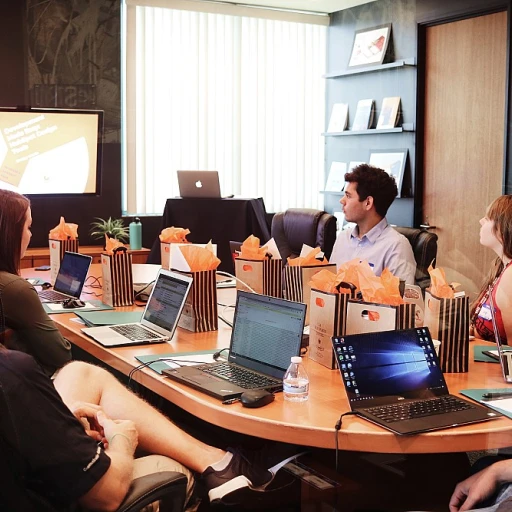
Understanding the Importance of Strategic Learning
Why Strategic Learning is Crucial in Today's Dynamic World
In today's rapidly changing world, organizations and individuals need to continually adapt and reinvent their strategies to stay competitive. This is where strategic learning comes into play. It is not just about acquiring new skills, but about understanding the broader learning process and applying strategic choices to achieve academic success and business goals.
The importance of strategic learning cannot be overstated. Organizations and students alike are poised to gain a competitive advantage by harnessing strategic insights and strategies. This involves evaluating existing skills and identifying gaps that need to be filled through reskilling. Whether you are in academia or the business world, the ability to implement a well-structured learning strategy can lead to significant outcomes, such as enhanced test preparation, improved time management, and successful change management.
For those involved in strategy leadership, understanding how to integrate strategic learning into everyday work is critical for the success of any strategy implementation. As pointed out in various learning development platforms from business schools across the United States and beyond, a winning proposition is built on the foundation of continual learning and adaptation.
Read more on how strategic learning can transform your approach to reskilling and help you maintain a competitive edge in today's market by exploring mastering the art of improvisation in reskilling.
Identifying Key Skills for Reskilling
Identifying Essential Skills for Career Growth
In the journey of reskilling, understanding which skills are crucial for future success is a foundational step. As industries evolve, so do the skills that provide a competitive advantage. Businesses and individuals must focus on strategic choices that align with both current and emerging trends within their sector.
The learning process demands a strategic evaluation of both core and soft skills. For many organizations, essential skills often encompass a blend of technical capabilities and attributes such as strategic leadership, change management, and effective time management. By honing these skills, professionals can better position themselves within the United States or internationally, including regions like southern Asia.
A recommended approach is to start with an assessment of current competencies. This can be achieved through reading relevant business and academic literature, such as resources from esteemed business schools. These materials often provide rich insights into industry-specific demands and strategic choices that lead to academic success and organizational change.
To address the individual aspect of reskilling, individuals may consider engaging in a learning development program or reading materials such as Reinventing Strategy and other management books that offer comprehensive strategies for skill enhancement. Utilizing technology can streamline the identification of key skills needed in contemporary work environments, enhancing the strategic learning process.
For those embarking on this journey, learning from the success stories of others within the workforce can highlight the pivotal skills that drive success. Ultimately, establishing a structured strategy for identifying and acquiring these skills will pave the pathway to fulfilling careers and cater to the evolving needs of both students and professionals.
For more practical techniques on reskilling, the article on innovative productivity techniques offers valuable guidance.
Creating a Personalized Learning Path
Crafting Your Unique Learning Journey
Embarking on a reskilling journey requires more than just identifying new skills; it's about creating a personalized learning path that aligns with your strategic goals. This process begins with the evaluation of your current skillset and the determination of how it meets the evolving demands of the workplace. From there, it's important to strategize effectively to ensure that the learning process is both relevant and effective. Whether you're aiming for academic success in a business school or seeking to maintain a competitive advantage in your organization, the approach remains the same: select a learning strategy that is comprehensive and adaptive to changes, both anticipated and unforeseen.- Time Management: Allocate time appropriately. Strategic choices must be guided by how much time you can commit to learning while balancing work, family, and leisure.
- Learning Formats: Consider different formats - such as online courses, workshops, or even reading influential management books - to broaden your approach. Selecting the right mix can prevent burnout and keep the learning process engaging.
- Goal Alignment: Regularly align your learning path with larger business or organizational objectives. This ensures that your acquired skills remain relevant in environments such as the fast-paced tech industry in the United States or the rapidly changing markets in Southern Asia.
- Continuous Evaluation: Utilize regular evaluations to track your progress and adjust your learning path as necessary. This ensures that you are not deviating from your end-goals and aids in strategy implementation.
Leveraging Technology in Strategic Learning
Embracing Digital Tools for Learning
In today's fast-paced world, technology plays a pivotal role in strategic learning. By leveraging digital tools, students and professionals can streamline their learning process, making it more efficient and effective. The integration of technology in learning development offers a competitive advantage, allowing individuals to adapt quickly to changes in the business landscape.
Utilizing E-Learning Platforms
E-learning platforms have revolutionized the way we approach education and training. These platforms provide a wealth of resources, from academic courses to professional development programs, enabling learners to tailor their learning strategies to fit their specific needs. This flexibility is crucial for achieving academic success and ensuring that the learning process aligns with strategic choices.
Incorporating AI and Machine Learning
Artificial intelligence and machine learning are transforming the way organizations approach reskilling. These technologies offer insights into learning evaluation, helping to identify areas where learners may need additional support. By analyzing data, AI can provide personalized recommendations, enhancing the learning experience and ensuring that time spent on learning is used effectively.
Enhancing Engagement through Interactive Content
Interactive content, such as simulations and gamified learning experiences, can significantly boost engagement and retention. This approach to learning encourages active participation, making the learning process more enjoyable and effective. It also supports strategy implementation by providing real-world scenarios that prepare learners for practical application in their work.
Implementing Mobile Learning Solutions
With the rise of mobile technology, learning on-the-go has become more accessible than ever. Mobile learning solutions allow individuals to access educational content anytime, anywhere, facilitating better time management and supporting continuous learning. This adaptability is particularly beneficial for those balancing work and study, ensuring that learning remains a priority.
Overcoming Challenges in the Reskilling Journey
Facing Obstacles Head-On in Your Reskilling Adventure
Embarking on a reskilling journey is a commendable endeavor, yet it is accompanied by its unique set of challenges. Understanding and navigating these obstacles can be critical to achieving success in the strategic learning process. Here’s how you can manage and overcome these hurdles effectively. Firstly, recognize the potential for resistance to change within organizations or even within oneself. Change management plays a vital role here. Encourage a mindset open to growth and learning by focusing on the long-term benefits of reskilling, both for individual advancement and organizational innovation. Time management can also serve as a substantial barrier. Juggling existing work commitments, personal responsibilities, and reskilling efforts requires careful strategic planning. Establishing a time management strategy that allocates dedicated periods for learning and reflection ensures that the reskilling process aligns with both your academic pursuits and business goals. Utilizing insights from various business and academic realms can give your strategy a competitive edge. Reading relevant literature and adopting strategies from reputable sources in strategic learning will provide valuable guidance. Books and academic materials are rich resources for broadening your perspective and refining your strategic choices. Learning evaluation is another critical factor to consider. Developing a framework for assessing your progress can prevent you from veering off course. Set tangible milestones and conduct regular evaluations to measure progress. This ongoing assessment not only helps in tracking success but also identifies areas that require improvement. Lastly, involve faculty staff and experienced mentors in your reskilling journey. Their experiences and knowledge about strategic learning can provide the support and expertise needed to navigate complex challenges. Successfully overcoming these challenges requires resilience and adaptability. Through careful planning and a proactive approach, anyone can turn these potential roadblocks into stepping stones toward a successful reskilling journey.Measuring Success and Continuous Improvement
Evaluating Success and Driving Continuous Development
As you embark on your reskilling journey, it's crucial to recognize the importance of evaluating your success regularly. Strategic learning requires a thorough learning evaluation process to ensure that you are achieving your goals and making informed strategic choices. This continuous evaluation allows you to refine your learning strategy, adapt to any changes, and strengthen your competitive advantage.
In the context of both students and professionals, the learning evaluation process is essential for academic success and effective strategy implementation. It provides valuable insights into what works and what doesn't, enabling organizations and individuals to tailor their learning development efforts.
To effectively measure success in your reskilling efforts, consider these steps:
- Implement a feedback mechanism: Regular feedback from peers, faculty staff, or mentors can guide your learning process and help you identify areas for improvement.
- Set clear and achievable goals: Identify key skills you wish to acquire and use time management techniques to stay on track.
- Leverage technology: Utilize digital tools and platforms to track progress and access strategic resources tailored to your learning goals.
- Apply strategic leadership: Use insights drawn from strategic choices to realign your goals and maintain a winning proposition.
Continuous development doesn't end with formal learning. It involves applying the knowledge and skills gained to real-world scenarios, which can help foster social change and bring about significant improvements in business and academic environments. The principles of change management can greatly enrich your strategy leadership capabilities, producing lasting reforms within your sphere.
Transformation journeys in reskilling are everlasting, and by adopting a mindset of perpetual evaluation and refinement, you not only work towards personal growth but also contribute to the broader objectives of your organization or educational institution. The insights gained through this process help in maintaining a reinforced approach to strategic learning and reinventing strategy in an ever-changing landscape.
Remember, mastering strategic learning is a dynamic process that requires commitment and adaptability, whether you are in the United States, southern Asia, or anywhere in between. Stay open to change and integrate these strategies to navigate the complexities of modern-day reskilling.













